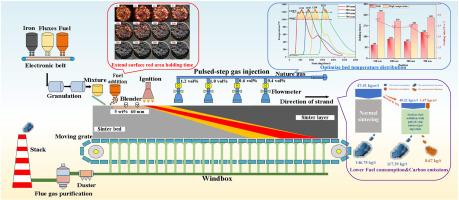表面燃料添加与脉冲步进天然气注入在铁矿石烧结中的应用:热分布与工艺优化
IF 10
1区 环境科学与生态学
Q1 ENGINEERING, ENVIRONMENTAL
引用次数: 0
摘要
富氢注气技术是烧结矿作为高炉主要原料的国家和地区低碳烧结研究的一个重要领域。然而,表面烧结指数不足,使得即使高浓度的注气也不足以解决这个问题,这对目前的烧结厂提出了迫切的挑战。针对这一问题,本文提出了一种新的方法——表面燃料添加技术来增强喷气烧结,结果表明,在烧结床表面添加5 wt%的燃料,使表面收率从43.05%提高到54.57%,总收率从69.11%提高到76.03%。这种改善归因于在红色区域停留时间的增加和上层热状态的优化,但导致注气间隔的推迟。注入浓度为0.8%的天然气8 ~ 16 min后,烧结指标与基准相近,但床层温度变化较大,表层和上层的熔体保温时间增加,中层和下层的熔体保温时间减少。因此,提出采用脉冲阶跃喷射方式,加强中下层供热,进一步降低焦炭风用量15%。由于表面燃料比例高,烧结初期烟气中CO含量由1.20%增加到1.90% ~ 2.03%,CO和NO平均排放浓度分别下降了8.96%和30.66%。一台360平方米的烧结机(年产320万吨),每年可减排焦炭27680吨,二氧化碳约66208吨,有利于钢铁行业的可持续发展和环境保护。本文章由计算机程序翻译,如有差异,请以英文原文为准。


Application of surface fuel addition coupled with pulsed-step natural gas injection in iron ore sintering: heat distribution and process optimization
Hydrogen-rich gas injection technology represents a critical area of research in low-carbon sintering for countries and regions where sinter serves as the primary raw material for blast furnaces. However, the surface sinter index is insufficient, rendering even high concentrations of gas injection inadequate to address this issue, which poses an urgent challenge for current sintering plants. Therefore, this paper introduces a novel approach, surface fuel addition technology, to enhance gas injection sintering in response to this problem, the results indicate that the addition of 5 wt% fuel to the surface of the sintering bed enhances the surface yield from 43.05% to 54.57% while the total yield increases from 69.11% to 76.03%. This improvement is attributed to an increased residence time in the red zone and an optimized thermal state in the upper layer, but results in a postponement of the gas injection interval. After injecting natural gas with a concentration of 0.8 vol% in 8–16 min, the sintering indexes are similar to the benchmark but the bed temperature is greatly changed, the melt holding time of surface and upper layer increased while that of middle and lower layer decreased. Therefore, the pulsed-step injection mode is proposed to strengthen the heat supply in the middle and lower layers and further reduce the coke breeze usage by 15 %. Furthermore, the CO in flue gas in the early stage of sintering increases from 1.20% to 1.90%–2.03% because of the proportion of surface fuel is high while the average CO and NO emission concentration decrease by 8.96% and 30.66%. For a 360 m2 sintering machine (annual output of 3.2 million tons), 27680 tons of coke breeze and about 66208 t CO2 can be reduced per year, which is beneficial to the sustainable development of iron and steel making and protection of environment.
求助全文
通过发布文献求助,成功后即可免费获取论文全文。
去求助
来源期刊

Journal of Cleaner Production
环境科学-工程:环境
CiteScore
20.40
自引率
9.00%
发文量
4720
审稿时长
111 days
期刊介绍:
The Journal of Cleaner Production is an international, transdisciplinary journal that addresses and discusses theoretical and practical Cleaner Production, Environmental, and Sustainability issues. It aims to help societies become more sustainable by focusing on the concept of 'Cleaner Production', which aims at preventing waste production and increasing efficiencies in energy, water, resources, and human capital use. The journal serves as a platform for corporations, governments, education institutions, regions, and societies to engage in discussions and research related to Cleaner Production, environmental, and sustainability practices.
 求助内容:
求助内容: 应助结果提醒方式:
应助结果提醒方式:


